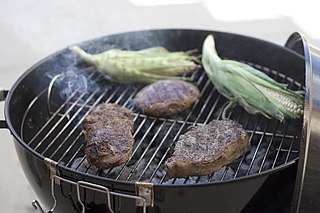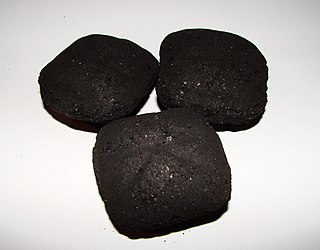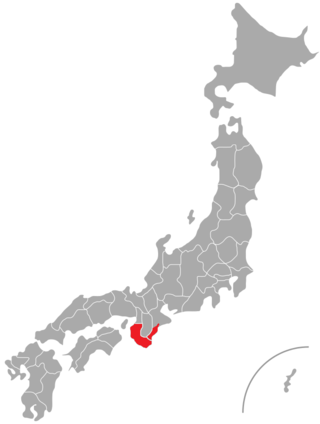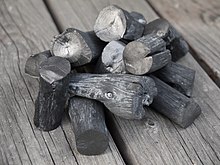
Ash is the solid remnants of fires. Specifically, ash refers to all non-aqueous, non-gaseous residues that remain after something burns. In analytical chemistry, to analyse the mineral and metal content of chemical samples, ash is the non-gaseous, non-liquid residue after complete combustion.

Smoking is the process of flavoring, browning, cooking, or preserving food, particularly meat, fish and tea, by exposing it to smoke from burning or smoldering material, most often wood.

Gobō is a city located in Wakayama Prefecture, Japan. As of May 2024, the city had an estimated population of 21,260 in 10,801 households and a population density of 480 persons per km2. The total area of the city is 43.91 square kilometres (16.95 sq mi).

A barbecue grill or barbeque grill is a device that cooks food by applying heat from below. There are several varieties of grills, with most falling into one of three categories: gas-fueled, charcoal, or electric. There is debate over which method yields superior results.

A briquette is a compressed block of coal dust or other combustible biomass material used for fuel and kindling to start a fire. The term is a diminutive derived from the French word brique, meaning brick.

Citrus unshiu is a semi-seedless and easy-peeling citrus species, also known as the satsuma mandarin or Japanese mandarin. During the Edo period of Japan, kishu mikans were more popular because there was a popular superstition that eating Citrus unshiu without seeds made people prone to infertility. Citrus unshiu became popular in Japan after modernization started in the Meiji period. It was introduced to the West from the Satsuma region of Japan in 1878.

Teaware is a broad international spectrum of equipment used in the brewing and consumption of tea. Many components make up that spectrum, and vary greatly based upon the type of tea being prepared, and the cultural setting in which it is being prepared. This is often referred to as the tea ceremony, and holds much significance in many cultures, particularly in northwestern Europe and in eastern Asia. A complete, cohesive collection of tea ware makes up a tea set.

Bincho-tan is a mascot character, created by Japanese manga artist Takahito Ekusa and produced by game goods company Alchemist.

Tea utensils are the tools and utensils used in chadō, the art of Japanese tea.

The Classic of Tea or Tea Classic is the first known monograph on tea in the world, by Chinese writer Lu Yu between 760 CE and 762 CE, during the Tang dynasty. Lu Yu's original manuscript is lost; the earliest editions available date to the Ming dynasty.

Bamboo charcoal is charcoal made from species of bamboo. It is typically made from the culms or refuse of mature bamboo plants and burned in ovens at temperatures ranging from 600 to 1,200 °C. It is an especially porous charcoal, making it useful in the manufacture of activated carbon.

Shichirin is a small Japanese charcoal grill.

The Kishu Ken, sometimes called Kishu Inu or Kishu dog, is a Japanese breed of dog. It is descended from ancient medium-sized breeds and named after the Kishu region, now Mie Prefecture and Wakayama Prefecture. It was designated a living national monument of Japan in 1934. Kishu have been prized since prehistoric times for boar and deer hunting. Like the Shiba, they are often quiet. Kishu will stalk prey quietly rather than bark. They are the most commonly used purebred native Japanese breed used for hunting boar to this day.

A kamado is a traditional Japanese wood- or charcoal-fueled cook stove.

The Kojiki and Nihon Shoki, compiled in the 700s, were the first books in Japan to describe citrus fruits. The Nihon Shoki states that a man named Tajimamori brought back citrus fruits from the Tokoyo no kuni on the orders of Emperor Suinin, which is thought to refer to the tachibana orange that grows wild in Japan. The Man'yōshū, a collection of poems from the same period, contains many poems about tachibana orange, and because of its strong acidity at the time, it was dried and used for medicinal and ornamental purposes rather than for food. The Kokin Wakashū, compiled in the 900s, mentions that tachibana orange was burned and used as incense to give a nice fragrance to kimonos. In Japan, tachibana orange is a symbol of eternity and is the motif for the Order of Culture.

Wood ash is the powdery residue remaining after the combustion of wood, such as burning wood in a fireplace, bonfire, or an industrial power plant. It is largely composed of calcium compounds, along with other non-combustible trace elements present in the wood, and has been used for many purposes throughout history.

Charcoal is a lightweight black carbon residue produced by strongly heating wood in minimal oxygen to remove all water and volatile constituents. In the traditional version of this pyrolysis process, called charcoal burning, often by forming a charcoal kiln, the heat is supplied by burning part of the starting material itself, with a limited supply of oxygen. The material can also be heated in a closed retort. Modern charcoal briquettes used for outdoor cooking may contain many other additives, e.g. coal.

Yakitori is a Japanese type of skewered chicken. Its preparation involves attaching the meat to a skewer, typically made of steel, bamboo, or similar materials, after which it is grilled over a charcoal fire. During or after cooking, the meat is typically seasoned with tare sauce or salt. The term is sometimes used informally for kushiyaki in general.

Artists' charcoal is charcoal used as a dry art medium. Both compressed charcoal and charcoal sticks are used. The marks it leaves behind on paper are much less permanent than with other media such as graphite, and so lines can easily be erased and blended. Charcoal can produce lines that are very light or intensely black. The dry medium can be applied to almost any surface from smooth to very coarse. Fixatives are used with charcoal drawings to solidify the position to prevent erasing or rubbing off of charcoal dusts.

The Kishū dialect is a Kansai dialect of Japanese spoken in the former Kii Province, in what is now Wakayama Prefecture and southern Mie Prefecture. In Wakayama Prefecture, the dialect may also be referred to as the Wakayama dialect.





















